Decluttering an entire home is a mammoth task that will likely be tiring and perhaps emotionally draining. But with a solid plan, a well-thought-out urgency list, and a bit of patience, you will get there.
Follow the steps below to declutter your home right now!
Stop Making These Mistakes When Decluttering
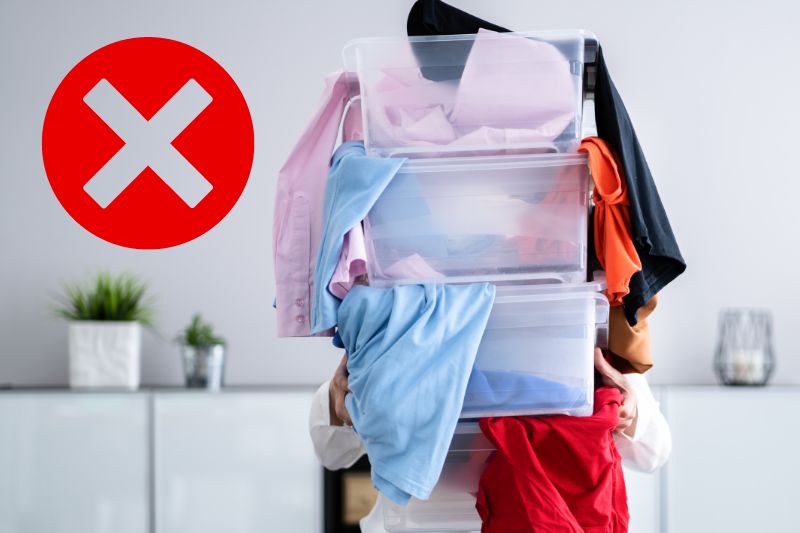
Before you start your decluttering journey, check out the common mistakes below, so you don’t make them on your adventure:
- Stop organising your home instead of decluttering it!
- Don’t expect the decluttering process to stop when you’ve finished one job. The entire process is ongoing! And as you buy more stuff, move house, or rearrange your home, you’ll have to declutter again.
- Don’t start the decluttering process without a plan in mind. A plan will guide you throughout this process and will keep tasks under control for you.
- Don’t rush the process to get it done quickly. Decluttering can be emotionally draining and incredibly tough. So, take your time and get support throughout this process.
- You shouldn’t tackle mammoth tasks in one go. Break each task into many little jobs. It’s also worth making a habit of doing small decluttering tasks each day so you can stay on top of the decluttering work! Plus, you won’t have mountains of goods to sort through if you do this.
- Don’t give up halfway through the decluttering process. Yes, the decluttering process will be tiring and draining in parts, and it may also seem a tad boring, but you’ve got to find the ‘wins’, fun, and mini motivators during this time.
- Don’t be overly ambitious. Set realistic goals you can achieve. If you go over the top with your goals, you’ll end up running out of energy and motivation for the decluttering tasks. Take it easy!
- Stop thinking about the decluttering process as an embarrassing task. This entire process is extremely rewarding, even though it may not feel like that all the time! There will be a positive outcome in the end for you. Plus, everyone declutters, if only a little bit, every so often.
- Stop second-guessing yourself when you’re decluttering. Make a decision and stand by it. Otherwise, you’ll be going around in circles, trying to decide what to do with each item.
- Accept that nothing is perfect, so don’t be fooled into thinking that the decluttering process has to be absolutely perfect! In fact, the decluttering process could be a messy one, and that’s fine!
- Don’t bin or donate all your items because you need some of your belongings. Decluttering doesn’t mean that you have to throw everything away and start a minimalist lifestyle from scratch. You will need to keep some stuff. Otherwise, you’ll have to go out and buy new goods, and that’ll work out expensive for you.
How to Declutter Your Home
Got some decluttering woes that are holding you back from starting the process?
Maybe you don’t know where to start decluttering, and you’re utterly overwhelmed by the thought of it all. Or perhaps you just want some tips on how to declutter a house in 15 minutes.
Whatever your story is, you can follow the steps below to declutter your home at your own pace!
Step 1: Create a plan on how you’ll go about decluttering your home
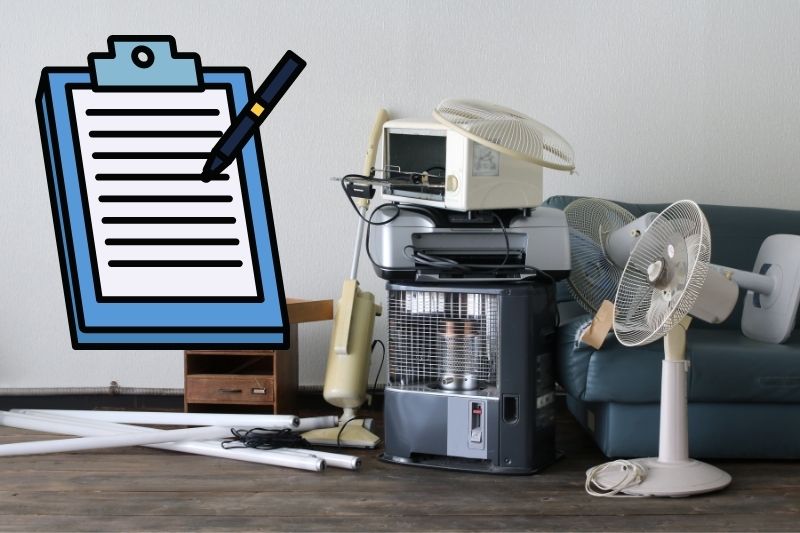
Write down the name of each room in your house, and next to it, note down what areas are particularly cluttered inside the room and what sections need your attention.
Once you’ve done this, you can break down each cluttered section into small manageable decluttering tasks for you to carry out.
If it helps, you can give each room and task an ‘urgency number’, so you can instantly recognise what rooms/jobs need your attention first and foremost.
For example, your ‘urgency numbers’ could go like this:
1 – Not very urgent and can be left for now.
2 – Needs attention but not immediately.
3 – Needs to be decluttered immediately.
At this point, you’ll have a clear ‘decluttering plan’ set out before you.
Further to the above, you should tell yourself how long to spend on each task and when to have a coffee break or to take time for lunch!
This may seem like a lot of needless work, but this solid structure will keep you on track throughout the decluttering process.
Step 2: Choose one space to declutter
With your plan outlined before you, choose a space to start working in (one with a high urgency number, ‘3’).
This could be a single kitchen cupboard, a small wardrobe, a bookcase, a worktop, or even your makeup drawer in the bathroom, for example.
Don’t attempt to declutter a whole room! It’s all about working in small, manageable sections.
If you try and clean an entire room, you’ll quickly lose track of what you’re trying to achieve, and your momentum will drop!
In addition, for your first few decluttering jobs, try to pick areas that don’t mean too much emotionally for you.
This way, you’ll be able to ease yourself into the work, and you won’t feel as emotionally attached to the items you’re tending to.
By doing it this way, you can also build up to more sensitive areas!
Step 3: Take photographs before you carry out the work
By taking pictures before you do any decluttering work, you’ll be able to see your progress at the end!
These are the ‘wins’ you need to see throughout this process, as they’ll provide you with a lot of motivation moving forward.
Step 4: Decide how you’ll separate your stuff
As a guide, you could separate your stuff into four piles: ‘keep’, ‘donate’, ‘bin’ and ‘repurpose’. (You don’t have to have a ‘repurpose’ pile).
However, it’s not uncommon for people to have ‘put away’ and ‘fix’ piles as well. This decision comes down to personal preference.
It’s also worth pointing out that you could use containers, rubbish bags and recycling bags to hold the goods you’re sorting out.
This will keep things tidy for you, and it also means that items are already bagged up and ready to go to the charity shop or recycling centre.
Step 5: Start to separate the items into piles
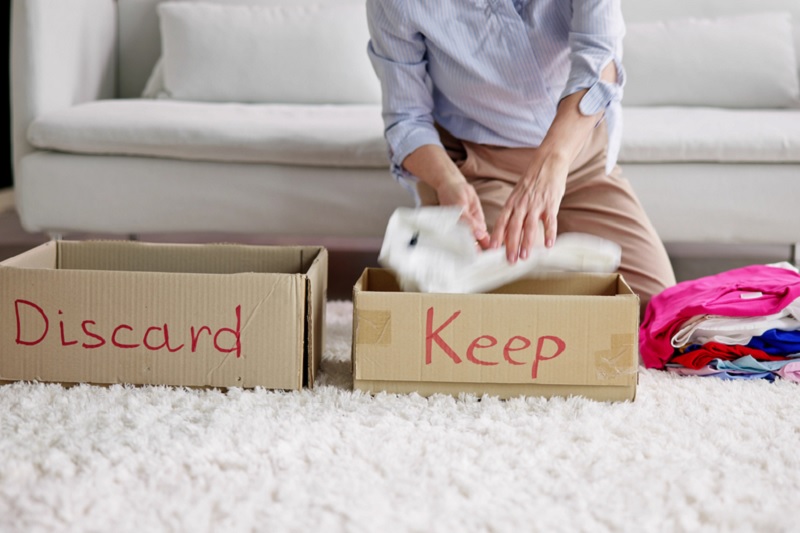
When you start decluttering, it’s okay if you take a few minutes to decide whether or not to keep an item. You’ll naturally speed up as you continue to declutter other areas in your home.
When deciding what to ‘keep’ and what to ‘bin’/’donate’, consider if the item in question serves its purpose, does it get used often, and does it bring you joy/make your life better.
If the thing does, then you should keep it. If not, it’s time to part ways with it because it’s serving no purpose other than to clutter up your home.
Step 6: You should now have ‘keep’, ‘donate’, and ‘bin’ piles
Once you’ve sorted out all the goodies in the area you’ve been decluttering, you should have at least three piles: ‘keep’, ‘donate’, and ‘bin’.
You can now take the items that need to be ‘binned’ or ‘donated’ out of the room to give you more space (they can be taken to the appropriate place later in the day/the next day).
Examples of items that can be donated include clothes, shoes and bags, whereas things that need to be binned are out-of-date foods!
It’s okay to move things from the ‘donation’ pile and back into your home. When you sleep on decisions, sometimes you realise that you’ve made the wrong choice.
If this is the case, keep the item and decide what to do with it at a later date.
Step 7: Think about what you’re going to do with the items in your ‘keep’ pile
It’s time to decide what you’re going to do with everything in your ‘keep’ pile. If you’ve opened up some shelving space, for example, put items in your ‘keep’ pile there.
Don’t be tempted to throw everything back into the cupboard or drawer out of the way. Put pieces, like ornaments and books, on display.
And if you’re going to pop things back into the space, try and think of better storage solutions.
For example, you could place condiments in cupboard trays in a cupboard, so you can remove the tray to get to the items when you need to use them.
Or you could use drawer separators to keep your utensils or make-up pieces organised when they’re not in use.
You can even put sticky tags on the trays/boxes, so you know what is in each container!
Step 8: Final checks
Have a look around to make sure that you’ve popped everything you need to store away back in its place and make sure you’ve not forgotten anything.
Step 9: Check your progress
Once you’ve done all of the above, you can look at the pictures you took at the start to see how far you’ve progressed!
You’ll be amazed by how much you’ll have achieved in a short space of time!
Step 10: The next step
Now that one area within one room is clear, you can pick a new space to declutter. And because you planned out your decluttering work beforehand, you should know roughly where you’re heading next.
For example, if your first area was a kitchen cupboard, your second area could be another cupboard or a drawer.
You’ll need to follow the steps above to declutter this new space. And as mentioned above, when you’re done with the second area, you can move on to the next place that needs your attention, as noted in your plan.
It’s always better to work in manageable areas so you can carry out the task with ease, not feel overwhelmed, and complete the job in a timely fashion.
Tips for Decluttering Your Home Quickly
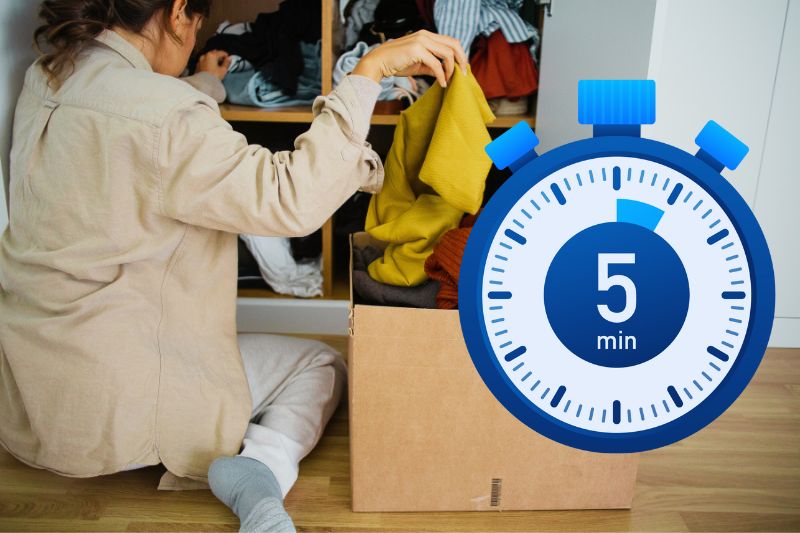
If you’re short on time, try out these super-speed decluttering tricks that are designed to remove the clutter from your home at warp speed!
Set a five-minute timer and declutter a specific room during these five minutes
Bin anything you don’t need and keep things that are valuable to you. If you do this type of decluttering activity every day, you’ll soon notice that the clutter vanishes from your home.
Plus, most people don’t even notice the timer going off after five minutes because they’re in the ‘decluttering zone’.
Grab a bag and fill it with everything you want to remove from a particular space
Once the bag is full, you stop what you’re doing and go and sort it out. In no time, you’ll see that a lot of stuff will have been removed from your home.
Change your perspective and see your home from a different angle!
This may seem silly, but if you look at a room from a new angle, you might be surprised by what you see.
Grab a step ladder and look down on your living room, sit in the middle of your kitchen floor, or stand on a chair in your bedroom to get a different view of your room.
It may sound weird, but you’ll be fascinated by how things look entirely different when you see them from a new viewpoint!
Doing this will likely mean that you’ll see clutter that you’ve not noticed before but also new spaces that could be better used.
Try the hanger method when decluttering clothes
All you need to do is pop all your clothes on a hanger in the wrong way and place them in your wardrobe. When you wear and wash your item, pop it back on the hanger the right way.
After about six months, you’ll notice that all the clothes you wear frequently will be on hangers facing the right way, but everything you haven’t worn will be facing the wrong way. You’ll instantly know what clothes need to be donated by doing this.
Try the four-box method of decluttering
All you have to do is walk into a room with four boxes: ‘keep’, ‘rubbish’, ‘donate’, and ‘relocate’. Your job is to walk into a room and pop everything inside the space into one of the four boxes.
Of course, some items physically won’t fit into a box, so for these, you can use a sticker.
But the goal is to put everything into a box/stickered so you know exactly what to do with each item.
Some Decluttering Rules Professionals Use

Below you’ll find a handful of rules decluttering professionals use to help their clients keep their properties in check. Here are the most popular rules explained:
The 20/20 rule
The 20/20 rule suggests that you should get rid of an item if you don’t use it and can buy a replacement item for less than £20 (or $20) and in less than 20 minutes.
The 5-second rule
The 5-second rule stipulates that when you pick up an item, you’ve got to remember when you last used it/wore it within 5 seconds.
If you can’t remember when you used/wore the item within the 5-second limit, you have to get rid of the item in question.
The 3-second rule
The 3-second rule is when you give yourself 3 seconds to decide whether or not to keep an item.
If you still can’t choose after 3 seconds have passed, you should pop the item to one side and come back to it later on (perhaps the thing is more meaningful than you think).
This rule isn’t suitable for when you’re decluttering a home where there are lots of personal and emotional pieces, because you’ll want to spend more time assessing how to deal with these items.
The one in, one out rule
The one in and one out rule simply states that when you buy a new item, you should get rid of/donate an item you already have at home.
This stops you from having a build-up of stuff in your home and allows you to control how many things you have in a particular space at a time.
The 90/90 rule
This rule revolves around whether or not you have used a particular item within the last 90 days or if you will use it in the coming 90 days.
If you answer ‘no’ to both (so you haven’t used the item in 90 days and you’re not going to use it in the next 90 days), you may as well get rid of the item because it’s not serving a big enough purpose in your life.
Interestingly, you can change the number 90 to a bigger/smaller number if you like. You could say 100 days instead.
The 12-12-12 rule
The 12-12-12 rule notes that you should find 12 items to donate in your home, 12 things to throw away from your home, and another 12 items you want to keep, but you must store and use them effectively if they’re saved.
This is a very straightforward way of organising 36 pieces in your home.
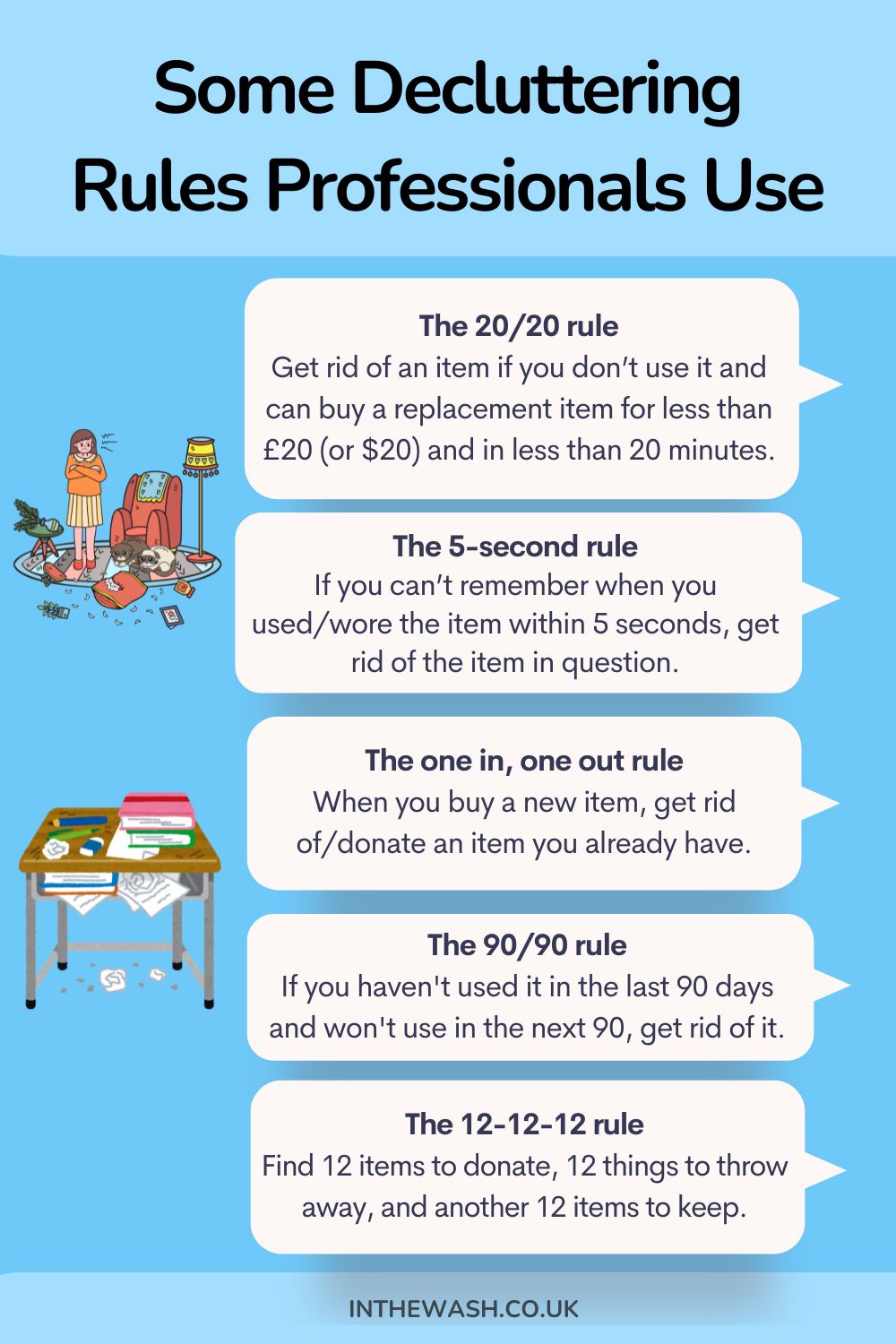
Additional Support

For more support when decluttering a house, you can watch some YouTube videos and ask family, friends and neighbours for help during the process.
You can even join dedicated groups where you can meet and discuss tips with other people who are decluttering.
Plus, you can offer emotional support to each other if you’re struggling with the sensitive side of decluttering a home.
Of course, you could always call a professional to help you declutter your home too! Pros in this field vary in price, so before you proceed with this method, do your homework!
Costs vary depending on where you’re located, what tasks are going to be carried out, when the work will be done, and who will be doing the work.

Bethan has a passion for exploring, reading, cooking and gardening! When she’s not creating culinary delights for her family, she’s concocting potions to keep her house clean!






